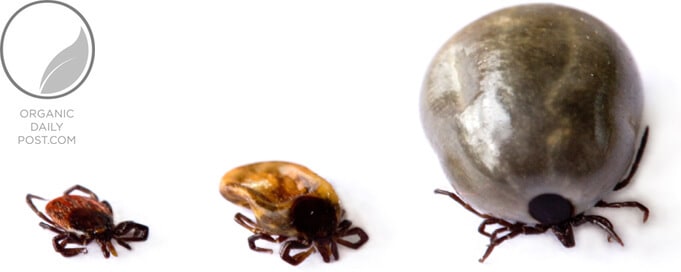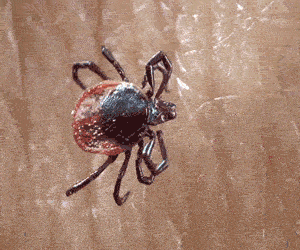
What Are Tick Tubes?
Tick tubes are a great first line of defense against nature’s Lyme disease carrying little nasties, the tick. If you live in an area where there are lots of ticks it may make sense to use tick tubes.
The use of tick tubes can reduce the tick population by up to 90%, making it one of the most effective tick control methods available.
If You Prefer All-Natural Tick Control...
...either in addition to or instead of synthetic chemicals, then you should see our article on using cedar oil for pest control.
How Do Tick Tubes Work?
In a symbiotic relationship, tick tubes use another little pest (the mouse) to kill the ticks for you. Ticks reproduce in mice nests and then use the mice to transport themselves across your yard.
The tick tubes contain cotton balls laced with a poison called permethrin. Permethrin is harmless to mice but effectively kills the ticks.
Permethrin Kills These Insects:
Crickets
Earwigs
Elm Leaf Beetles
Fire Ants
Fleas
Flies
Firebrats
Gypsy Moths
Millipedes
Pillbugs
Scorpions
Silverfish
Sod Webworms
Ants
Armyworms
Bees
Beetles
Borers
Boxelder Bugs
Centipedes
Chinch Bugs
Cockroaches
Sowbugs
Spiders
Ticks
Wasps
Here is how it works: the mice find the cotton balls in the tubes and carry them back to use as a nice, fluffy addition to their nests. That cozy cotton nest soon reveals its other side and kills all the young ticks while leaving the mice unaffected.
To use them, you place the tubes a few feet past your yard line (into the woods, tall grass, etc.) and put one down every 10 feet around the area you want to protect against ticks. Deploy them twice a year when the mice are mating and forming nests, which in the Northeastern US is April and July.
Where to Buy Tick Tubes
The easiest way to get tick tubes is to buy them online. For several years I bought Damminix tick tubes on Amazon.com but they are no longer in stock (thanks Covid).
You can still purchase them in various quantities to cover any size yard and they are ready to use out of the box. The tubes are even camouflaged so they aren’t visibly obvious.
A similar, cheaper and in-stock product is Thermacell tick tubes. There's not much to tick tubes so the differences are minimal but I've noticed that in the high demand season there can be a 1-2 month wait (!) on Amazon, so order early.
The drawback is that for what they are, they’re very expensive. A one-year treatment for a 1/2-acre yard is nearly $200. Given that, the best option is to just make your own. It is much cheaper, and not difficult at all.
How to Make Your Own Tick Tubes
Making your own tick tubes is easy. Cardboard tubes are basically free, just save them from toilet paper and paper towels (cut paper towel rolls into 2 or 3 segments).
Buy some cotton balls. The big, fluffy ones are best because there’s more surface area for poisoning and you can use fewer of them to stuff a roll tightly so that they stay in place.
Here are the components of tick tubes:
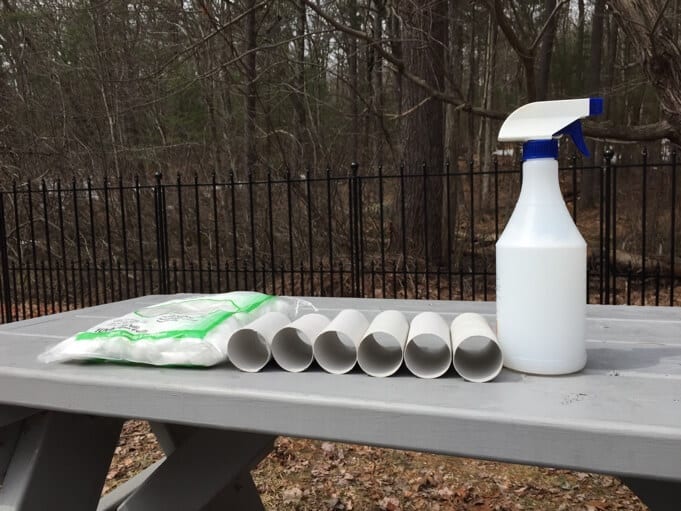
I usually place 24-30 tick tubes to cover roughly half an acre of usable yard space.

Before moving on to the permethrin section, I recommend protecting yourself when handling any poison so get some gloves and a mask, which hopefully you have on hand and at the ready.
Next, dilute the permethrin. The instructions on my bottle of permethrin SFR for reducing lawn tick populations call for 0.4 to 0.8 ounces of permethrin to 4 to 25 gallons of water. HOWEVER, that's for applications where you are spraying permethrin directly on the lawn.
The concentration of permethrin in tick tubes is 7.4%. So if you're using the bottle we recommend which is 10% permethrin, you can dilute it slightly or just use it as is.
Where to Buy Permethrin (the active ingredient)
The permethrin is the only ingredient that isn’t a normal household item. It's very easy to obtain though, just order some on Amazon.
It’s a 32 oz. bottle which is enough to last you a very long time if all you do is make tick tubes with it.
Add the permethrin to the water in the proper proportions in a spray bottle, then shake it up. Avoid shaking it in front of your face.
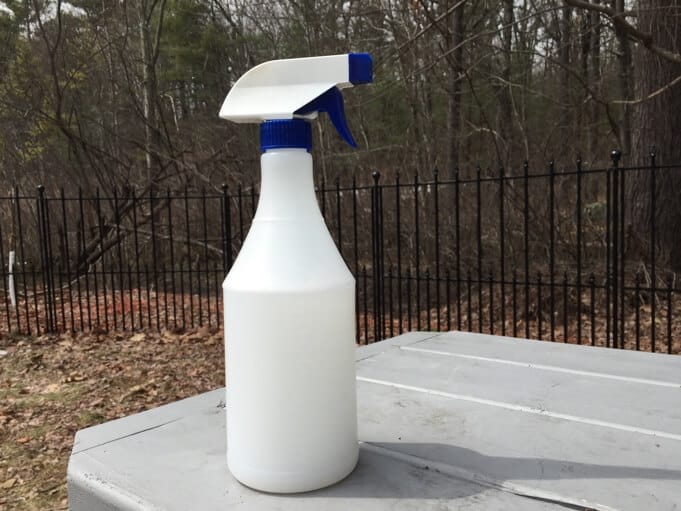
Digging through the recyclables will get you a plastic container to use for treating the cotton. Just throw the cotton balls in the container and spray it with the permethrin dilution using a spray bottle. Move the cotton around and make sure it’s well-treated.
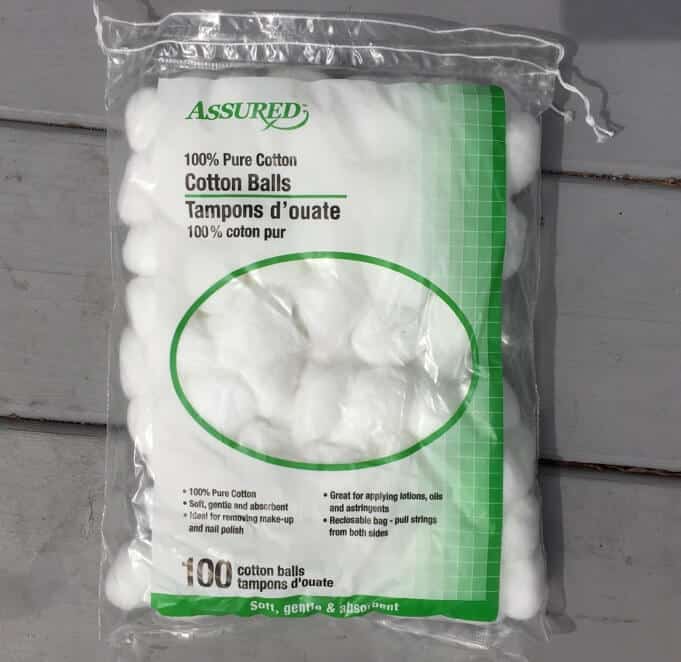
Here's a little video that brings it all together:
Let the cotton air out for a while then stuff the cotton balls into the tubes so they stay there. Not super tight, just tight enough that they don’t fall out easily.
Then spread them around the perimeter of your yard, a few feet past your yard line and spaced 10 feet apart from one another.
The idea is to let mice get to them, so make sure they are on the ground and you can even give them a little cover.
Pro Tip: You can use dryer lint instead of cotton balls inside the tick tubes; it works just as well (though it may not disintegrate as quickly). It takes some planning to collect that much dryer lint, but how many chances do you get to recycle dryer lint?
Just in case you’re worried about what it might look like to have toilet paper rolls all over your yard, the photo below is of one of these tubes with a few leaves sprinkled over them.
View from the road:

View from the woods. You can still barely see it:
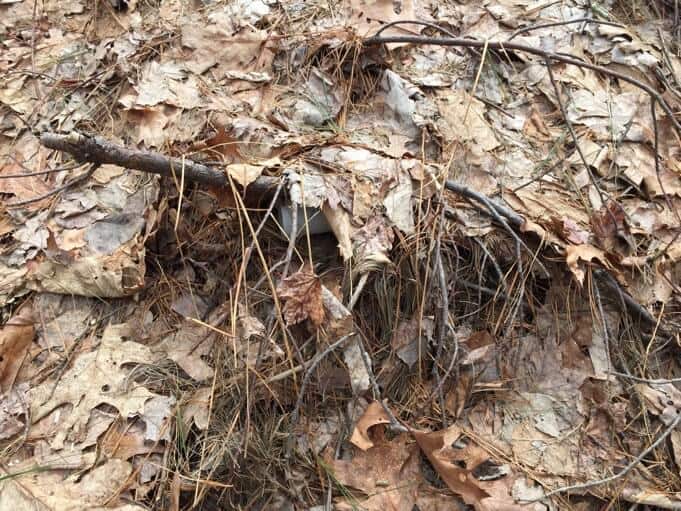
And that’s it! Save up your paper rolls over winter and by spring you’ll have all the ingredients you need to keep your family free from the bite of those disease-carrying ticks.
Tick tubes are effective but are only one of several tick killers for lawns. Use it as part of an overall tick defense strategy in areas where ticks are particularly concentrated and you will notice marked results.
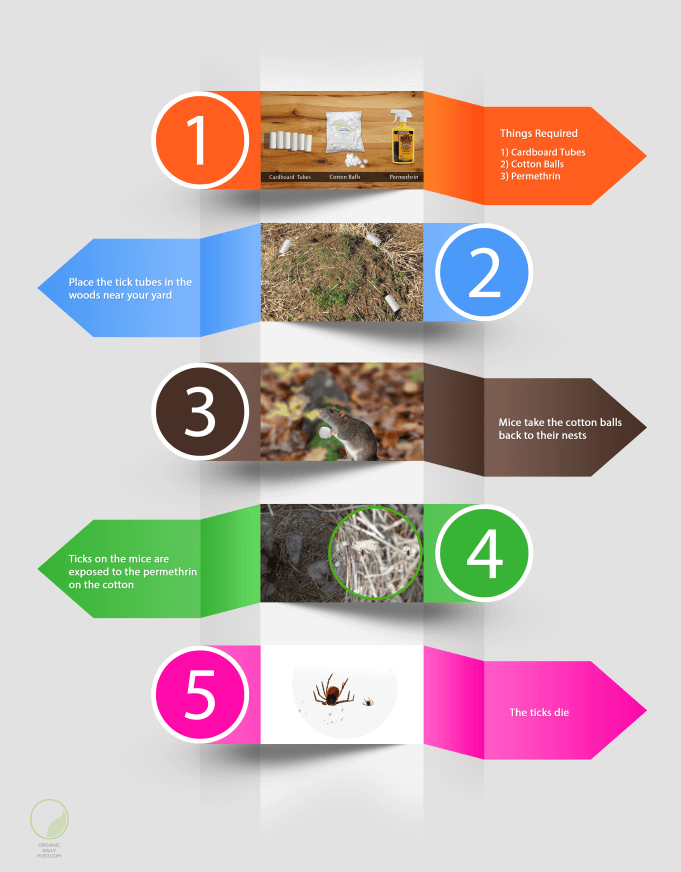
A Word About Permethrin
While deadly to ticks, a benefit of Permethrin is that it has low mammalian toxicity. That is, it's not very toxic to humans and other mammals. In fact, a form of it is used to treat scabies infections in humans.
That said, the same Cornell study linked above also stated "...contact with eyes, skin, or clothing should be avoided and handlers of permethrin should wash thoroughly after handling. Breathing of the spray mist or vapors of permethrin by workers should be avoided." It is somewhat poisonous so wear a mask and rubber gloves when handling it and make sure not to inhale the fumes.
We're very concerned with environmental toxins here at the Organic Daily Post, so we want you to know what you're dealing with.
Below are the first aid instructions for Permethrin, they do a pretty good job of letting you know what to be concerned about:
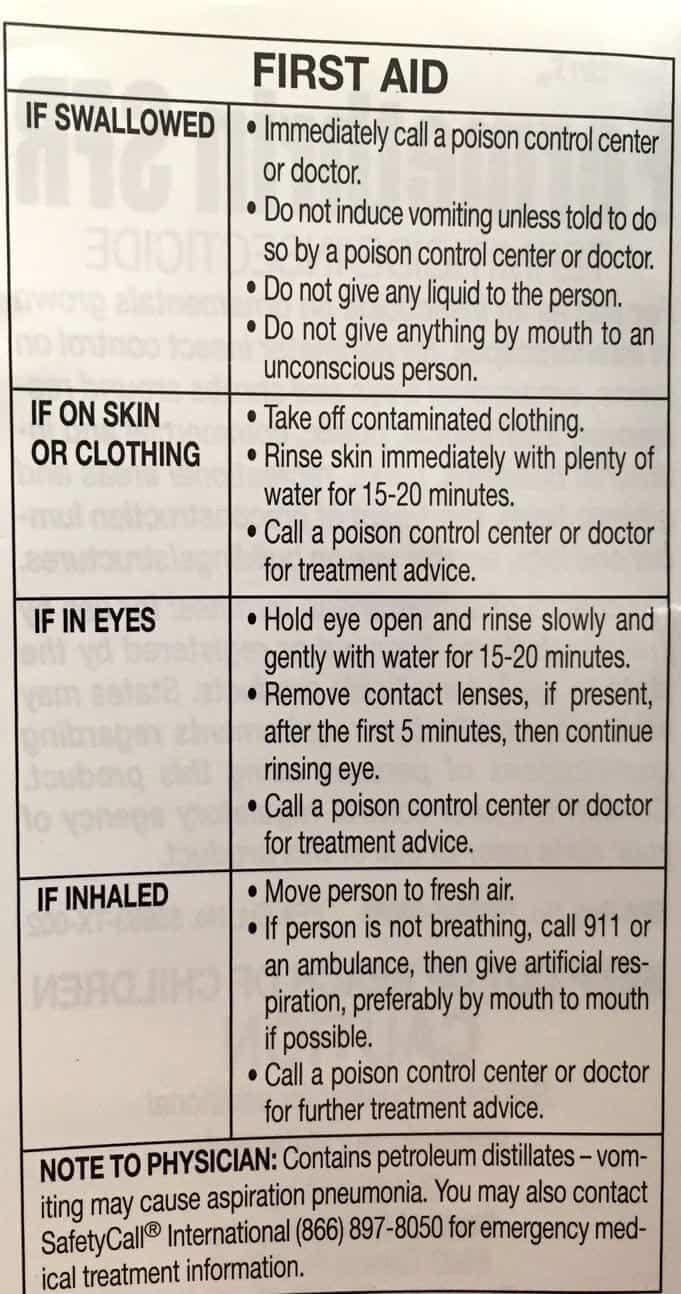
The tubes contain the poison and target it specifically to ticks, which is important. Permethrin can be used more broadly but be aware, permethrin is very dangerous to cats, fish, and insects in general including beneficial ones like bees and butterflies. So simply spraying it on your lawn would be ecologically hostile...keep it in the tubes please.
Frequently Asked Questions
Here are some common questions from our readers:
- Q: Are tick tubes effective?
A: Yes. They can reduce the tick population in a treated area up to 90% according to Damminix. They use a poison, permethrin, to kill ticks so it's not a natural solution but it does work when deployed as recommended. They need to be deployed twice per year, coinciding with the mating behavior of the mice that are the carriers of the poison (it doesn't poison the mice). It is toxic to fish so keep it away from bodies of water. It's also toxic to cats, which eat mice of course, so it's not without any drawbacks. Use them only if they make sense for you.
- Q: Where should I place the tick tubes?
A: Place the tick tubes around the perimeter of the area you intend to treat. They should be hidden; both for aesthetic reasons and so the mice can easily find them, as mice don't like to be in the open either. Put them just a couple feet from the yard area you're treating if possible. You want to place them just beyond the edge of the treated yard.
- Q: When should I use tick tubes?
A: Tick tubes are usually deployed in April and July, to coincide with the mating patterns of mice. Mice aren't harmed by the poison permethrin but they are carriers of ticks and the ticks reproduce in their nests. The mice transfer the permethrin to the ticks and kill them in the nests before they get to your yard. Mice mate in April and July so that’s when they’ll be in their nests and that’s when you deploy the tubes. Ticks are spreading rapidly globally though and this timing is designed for the northeastern United States as that’s where Lyme disease is most prevalent. If you live elsewhere this may vary for you.
- Q: How many tick tubes should I use?
A: Tick tubes are placed ten feet apart around the perimeter of the treated area. The number of tick tubes you need is directly related to the size of your yard or the area you intend to treat for ticks. We treat about a quarter acre of space and that takes about 24 tick tubes. When in doubt, use more than less because they dissolve in less time than you’d think and you want to make sure you eliminate the ticks. Tick tubes can be made at home very inexpensively as shown above.
- Q: Where can I buy tick tubes?
A: You can buy the original tick tubes at Amazon.com (Prime eligible if you do that like I do). When I have purchased them, that’s where I’ve done so. This is a good option if you don’t want to mess around with poison or just aren’t much of a do-it-yourself person. However, we use a lot of these at our house and that’s how we got started creating them ourselves. The components are all pretty cheap and if you follow the instructions above you should be all set in no time.
- Q: What are tick tubes?
A: Tick tubes are an effective way to reduce the population of ticks in your yard. They are cardboard tubes that contain a material (usually cotton) that mice use for nesting. The material is laced with a pesticide that kills ticks.
- Q: How do tick tubes work?
A: Tick tubes contain cotton that is laced with a pesticide to kill ticks. Mice take the cotton to make their nests, which kills the ticks on the mice. This works because mice are a major breeding ground for ticks and they help distribute them throughout your yard.
What are the most effective strategies for killing ticks in your area? Let us know in the comments below!
Take a look at our Lyme disease topic page to learn more.


